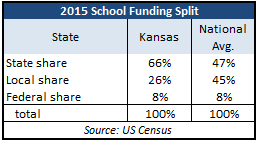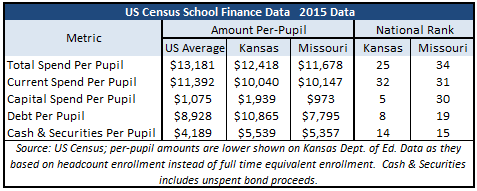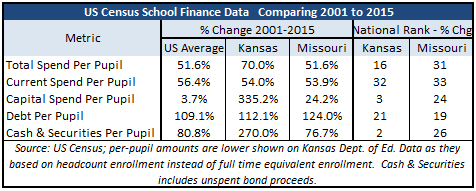New data from the U.S. Census Bureau shows Kansas had the 6th highest share of school funding provided by state government in 2015. State school funding comprised 66 percent of total funding in Kansas, while the national average  for state school funding was 47 percent. The national average for local taxpayer support was 45 percent but Kansas local taxpayers only provided 26 percent of funding. The federal taxpayers’ share of funding was 8 percent in Kansas and across the nation.
for state school funding was 47 percent. The national average for local taxpayer support was 45 percent but Kansas local taxpayers only provided 26 percent of funding. The federal taxpayers’ share of funding was 8 percent in Kansas and across the nation.
No other regional state comes close to Kansas for state school funding. The next highest share among neighboring states is Oklahoma at 49 percent, followed by Colorado (45 percent), Missouri (42 percent) and Nebraska (32.5 percent).
Kansas also made the Top Ten list for Capital Outlay spending per pupil and Bonded Indebtedness per pupil. Kansas’ $1,939 per pupil on Capital Outlay was the 5th highest spend in the nation and almost double the national average of just $1,075 per pupil. Kansas was #8 nationally for Bonded Indebtedness at $10,865 per pupil. Census uses headcount enrollment rather than full time equivalent enrollment as does the Kansas Department of Education for its per-pupil calculations, so the averages are a little lower than Kansans are used to seeing.
 At $12,418 per-pupil, Kansas is ranked #25 for total spending and is #32 for current spending (excluding Capital Outlay, Debt Service, Interest and other amounts designated by Census) at $10,040 per-pupil. Kansas had the 14th highest per-pupil Cash & Securities holdings in the nation, which, as explained recently, includes a little over $1 billion in unspent bond proceeds.
At $12,418 per-pupil, Kansas is ranked #25 for total spending and is #32 for current spending (excluding Capital Outlay, Debt Service, Interest and other amounts designated by Census) at $10,040 per-pupil. Kansas had the 14th highest per-pupil Cash & Securities holdings in the nation, which, as explained recently, includes a little over $1 billion in unspent bond proceeds.
Kansas also has relatively high rankings for growth rates since 2001. Total spending per-pupil growth of 70 percent was ranked #16 and far exceeded the national average of 51.6 percent. The growth in current spending was just below the national average (54 percent versus 56.4 percent) but Kansas could easily exceeded it if local school boards hadn’t put so much money into cash reserves.
 Kansas added $781 million to its Operating and Capital reserves between 2001 and 2015; diverting just 10 percent of that increase to current spending would have increased current spending per-pupil to the national average and still left $775 million in operating reserves and $412 million in capital cash reserves. And Kansas would still have had the 2nd highest Cash & Securities growth rate in the nation.
Kansas added $781 million to its Operating and Capital reserves between 2001 and 2015; diverting just 10 percent of that increase to current spending would have increased current spending per-pupil to the national average and still left $775 million in operating reserves and $412 million in capital cash reserves. And Kansas would still have had the 2nd highest Cash & Securities growth rate in the nation.




